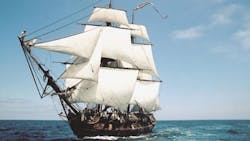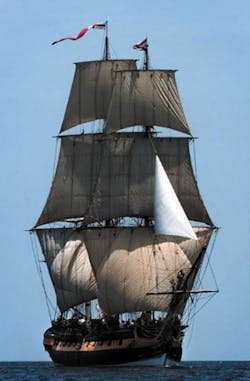Powering the world's largest motion platform
Try to imagine the size and power of the hydraulic system required to move a 60-ton movie prop mounted to the world's largest motion platform. But the dazzling special effects needed in Master and Commander: The Far Side of the World called for some dramatic engineering, not only in sheer physical capabilities, but in the sophistication of motion control as well.
The 60-ton prop is a full-size replica of the H.M.S. Surprise, a 179-ft sailing ship boasting a towering 130-ft main mast. From the outside, and the right vantage point, it looks just like a seaworthy sailing vessel. But inside, it's obvious that this is nothing more than a sophisticated stage prop.
Imagine the size and power of the hydraulic system required to move a 60-ton movie prop mounted to the world's largest motion platform. But the dazzling special effects needed in Master and Commander: The Far Side of the World, called for some dramatic engineering not only in sheer physical capabilities, but in the sophistication of motion control as well.
The ship replica is mounted to a huge motion platform capable of moving in three axes: roll (pivot along the longitudinal axis), pitch (pivot along the transverse axis), and heave (vertical displacement). Hydraulics brings life to this monstrous mechanism, and, as is usually the case in applications such as this, all hydraulic and mechanical motion components are hidden from view. Two giant hydraulic power units that drive the hydraulic system had to be hidden as well, so they were positioned more than 100-ft from the motion base. This presented a challenge to system design because such a long distance would normally slow response to sudden flow demands. However, proper line sizing and strategic placement of accumulators kept system dynamics within required specifications.
Each of the three motion axes had to produce smooth and precise motion, without jerky movements. Controls had to be easy to operate and allow making changes quickly on-the-fly. Safety was also important because roughly 130 actors, stunt men, other professionals, and extras were on board the Surprise replica during rehearsals and filming.
Setting the stage
Academy Award nominated director Peter Wier teams with Oscar winner Russell Crowe in this motion picture spectacle set on the high seas. Crowe stars as Jack Aubrey, a captain whose ship is suddenly attacked by a much superior enemy warship. Aubrey becomes a man on a mission and sets sail with his crew in a high-stakes chase across two oceans to intercept and capture their foe. Master and Commander: Far Side of the World (click to view trailer) is not only an epic tale of leadership and dedication, but a powerful story of the relationship between Aubrey and his trusted friend, played by Paul Bettany.
Before it was transformed into the H.M.S. Surprise for the film, the tall ship had been christened the H.M.S. Rose, and served as a floating museum in Bridgeport, Conn. Film makers purchased the Rose and converted it into the fictional H.M.S. Surprise. This seaworthy set is used in shots taking place out on the open seas. Because its movements can be precisely choreographed and controlled, the Surprise replica is used for closeups and scenes that must be carefully choreographed.
Film makers contracted Commander Productions Ltd., Los Angeles, to provide the Surprise facade mounted to the articulated steel framework, or gimbel, fixed to the bottom of a large tank at the shore of the Fox Studios set in Rosarito, Mexico (which was also used for the sea adventure films Titanic and Deep Blue Sea). This allowed commanding the ship replica through choreographed motions while it appeared to be far out at sea.
No bit-part for hydraulics
The sheer mass of this load made it a natural for hydraulics. Bosch Rexroth, Hoffman Estates, Ill., supplied the hydraulic system. The heave axis required the greatest force and stroke. To accomplish this, Bosch Rexroth provided four cylinders, each with an 8-in. bore, 8-ft stroke, and 2-in. piston rods. Not only did these cylinders transmit the most power in the application, they were the most critical because they were used in every scenario, and their motion had to be synchronized to handle the load and provide realistic motion. Had these cylinders moved out of synch, they could have applied uneven forces to framework. The resulting stress could have distorted the framework or even torn it apart.
For the roll and pitch axes, a Bosch Rexroth 4-ft stroke and 10-in. bore cylinder was specified for each. Although these axes required much shorter strokes, they still required large-bore cylinders operating at 1500 psi to move and control the 60-ton load. The motion of these cylinders was not synchronized, but each needed to work in tandem with the five other cylinders.
GS-Hydro U.S. Inc., Houston, also supplied the massive hydraulic power units, valves, and other hydraulic components, including 12 runs of more than 250 ft of hydraulic lines. According to Scott Cady, president of GS-Hydro, "Our design manager, Scotty Bearb, modelled a non-welded piping system in 3D that spanned a total of 4500 ft. The entire piping system was prefabricated in Connecticut and installed in Mexico in three weeks, after receiving the order."
Meeting high expectations
Since special effects have become a major segment of today's action movies, high expectations have been placed not only on equipment performance, but also on reliability. Once the film crew, special effects experts, actors, stunt men, and everyone else involved in a particular scene have assembled for a shoot, everything must work as planned. If anything doesn't, the lost production time can cost thousands of dollars per minute.
Dan Sudick, special effects coordinator at Commander Productions, considered the size of the mechanical system and complexity of controls, and mapped out many potential plans to operate the Surprise replica. Hydraulics were the clear choice for actuation because they could handle the dynamics of the application without question. The need for closed-loop motion control was also obvious because of the tight motion and position control requirements. The challenge was to provide an integrated system that could generate the power required to move the tremendous load through a wide range of motions and have everything look realistic.
But even though tight control was required, the resulting motion could not appear to be jerky or stiff. Fluidic motion was especially important for this application because a ship at sea pitches, heaves, and rolls smoothly. The only time a ship would jerk or move suddenly would be if it ran aground. So motion had to be highly damped to avoid any sudden movements.
Another challenge was the variable load presented by this giant stage prop. Buoyancy forces from the water caused the Surprise replica to become "lighter" as it became partially submerged. With a reduced load, the hydraulics could become too stiff, potentially creating unrealistic motion. This meant the system had to self-compensate for varying load conditions.
Controlling motion
The system was installed as it had been designed, but the expectations of the electrohydraulic servo control became higher than had been anticipated. This led Sudick to look for specialists in hydraulic controls. He chose Delta Computer Systems, Battle Ground, Wash. to help with this concern.
After the first run of the original system, the special effects people were skeptical as to whether the system would be controllable enough to meet their needs. They had to be convinced, and it needed to happen quickly because the shoot was scheduled to begin only a few weeks after the entire system had been installed.
Because Delta manufactures motion controllers designed for the special needs of hydraulics, they convinced Sudick that they understood the requirements of the hydraulic controls and had the solution.
Time was running short, so Delta suggested using a proven control systems integration company to integrate the motion controls. That is when Concept Systems Inc. entered the project.
An alternative solution
Michael Gurney, a founder and principal engineer at Concept Systems, went to the site immediately after the decision was made to go with Delta and installed and wired an RMC100 motion controller into the system. He then tuned the system, ran the motion program, and had the system running within six hours. This was unprecedented for a project of this stature.
Because Concept Systems was not brought into the project until it was nearly completed, very little time was available for testing. Nevertheless, Gurney had the ship rocking and rolling in two days, with less than ten hours to test it. This all was possible because of Concept Systems' extensive experience implementing challenging motion control solutions under demanding conditions.
To produce smooth motion of the platform, the RMC100 advanced tool was used set to run third-order cubic splines. This programming feature automatically sets optimum acceleration, deceleration and velocity based on simple operator commands. It accomplishes the same effect as variable damping of the system. But damping the system would have required re-engineering the hydraulic system, which was not an option. To simplify operation, Concept Systems added a PC-based operator interface, allowing for simple button-type interaction with the motion controller. This provided the look and feel the special effects crew was familiar with.
Dan Sudick was impressed with the whole system Concept Systems installed, especially the motion controllers. "The RMC100 controller is the best we've ever had," he offered. He added, "We can use this on many special effects requirements in other productions."
For more information, call Concept Systems at (866) 791-8140 or visit www.conceptsystemsinc.com.
The HMS Surprise is now docked at the Maritime Museum San Diego. Click here to see a video.
Editor's note:
After this article was originally published, a subscriber wrote with additional information. His comments, and a response from the article's author, are shown below.
Give credit where it’s due
Upon receiving the July issue of Hydraulics & Pneumatics , I was initially very excited. But upon completing the article about the upcoming movie, Master and Commander: Far Side of the World, I was very disappointed. The article gives Bosch Rexroth credit for work they did not perform. Specifically, author Johanson wrote, “Bosch Rexroth also supplied the massive hydraulic power units, valves and other hydraulic components including runs of more than 250 ft of hydraulic lines.”
To clarify, GS-Hydro supplied 12 runs of more than 250 ft of hydraulic lines and many valves. We are very disappointed that this article was allowed to be printed without involvement from all of the major contributors.
How the hydraulic fluid was transported from the hydraulic power units to the gimbel was a major concern for Fox Motion Pictures on this project. The special effects coordinator did not want a repeat of the type of problems the studio had experienced filming Titanic .
I personally spent three days in Rosarito, Mexico with our project manager, Peter Laneri, working with Dan Sudick and Ralph Kerr. GS-Hydro’s design manager, Scotty Bearb, 3-D modeled a non-welded piping system that spanned a total of 4500 ft. The entire piping system was prefabricated in Connecticut and installed in Mexico in three weeks from time of order.
I, for one, will be at the movie theater November 14th watching the boat rock and roll, and I hope that by then I won’t be the only one who knows that it takes many great products, people, and ideas to make hydraulic special effects electrify an audience.
Scott Cady, president, GS-Hydro U.S. Inc. Bloomfield, Conn.
Editor’s response:
Author Johansen acknowledged that the hundreds of feet of piping were, indeed, provided by GS Hydro. He brought this to our attention after initial approval of the manuscript, but the issue had already gone to press.
About the Author

Leaders relevant to this article:






